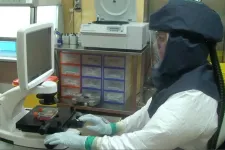SARS-CoV-2 mutations in competition
2021-02-26
(Press-News.org) Prior to the emergence of new mutants of the coronavirus, such as the British variant B.1.1.7, the SARS-CoV-2 variant named D614G had already mutated from the original SARS-CoV-2 pathogen that triggered the pandemic. D614G has rapidly spread to become the most abundant variant worldwide and this D614G mutation remains in all the new emerging variants. An international team including researchers from Bern has now been able to demonstrate in both the laboratory and in animal models why the D614G variant was able to gain the upper hand over the original SARS-CoV-2 virus. "Our approach also allows us to characterize emerging mutations such as the British variant B.1.1.7 better and quicker," says Volker Thiel of the Institute of Virology and Immunology (IVI), one of the four lead authors of the study. The findings are extremely important for assessing the risk of new mutants running rampant, as they show how a fitness advantage of virus variants can lead to higher transmission. First results were released earlier allowing for scientific discussion on what is known as a preprint server. The results of the study have now been published in full in Nature.
The D614G variant carries a mutation in the spike protein that makes it easier for the virus to dock onto human cells. The researchers at IVI and in David E. Wentworth's laboratory at the Centers for Disease Control and Prevention in Atlanta (USA) first demonstrated in human cell cultures from the upper respiratory tract, as well as from the nose, that the D614G variant binds more strongly and also replicates faster than the original virus. The increased replication of the D614G variant was also confirmed in vivo, in a new mouse model first described in this study. These experiments were also carried out at the IVI in Charaf Benarafa's group.
The new mutation clearly prevails
The spread of SARS-CoV-2 viruses can be studied better in other animals rather than mice. Hamsters and ferrets are well established in infection research and are especially suitable animal models. To compare the two variants, a mixture of equal parts of the original version of the SARS-CoV-2 virus and the D614G variant was applied into the nose of each animal under light anesthesia. After one day, experimentally infected animals were rehoused with another healthy sentinel animal of the same species, to evaluate the transmission of the two variants in direct competition with each other. The experiment was repeated with six pairs of animals in total. In virtually all sentinel animals, the proportion of transmitted SARS-CoV-2 viruses was massively dominated by the D614G variant early on. The differentiation of the variants was carried out using the latest sequencing technology and PCR techniques by Martin Beer's team at the Friedrich Loeffler Institute, Federal Research Institute for Animal Health, in Greifswald-Insel Riems (D). "Our study stands out because we were able to clearly discern the more efficient transmission of the mutated variant in direct comparison with the original variant," says Volker Thiel.
A fitness test for further mutations
This approach can even be used to test any single mutation or a specific combination of mutations that are present in a number of currently circulating viral variants. The IVI relies on a cloning technique developed in Bern a year ago, in which SARS-CoV-2 viruses can be exactly reproduced in the laboratory. The British virus, for example, is known to have not just one but often more than 14 mutations, eight of which occur in the spike protein. Thus, with the help of the cloning technique, any number of mutations of variants can be reproduced and used to compete against each other in the established cell cultures and animal models. The results show how single mutations affect the fitness and transmissibility of new variants. "Our testing strategy allows us to rapidly examine why other, newly emerging virus variants have become established," says Volker Thiel.
Similar research projects on infectious pathogens could also be carried out in the future at the newly established Multidisciplinary Center for Infectious Diseases and Immunity (MCIDI) at the University of Bern.
INFORMATION:
The study was financially supported by the Swiss National Science Foundation SNF, the European Commission, the German Federal Ministry of Education and Research, and the U.S. Department of Health & Human Services, National Institutes of Health (NIH) / Institute of Allergy and Infectious Diseases (NIAID).
[Attachments] See images for this press release:

ELSE PRESS RELEASES FROM THIS DATE:
2021-02-26
A study, led by researchers at the Instituto de Astrofísica de Canarias (IAC) and carried out with OSIRIS, an instrument on the Gran Telescopio Canarias (GTC), has found the most densely populated galaxy cluster in formation in the primitive universe. The researchers predict that this structure, which is at a distance of 12.5 billion light years from us, will have evolved becoming a cluster similar to that of Virgo, a neighbour of the Local Group of galaxies to which the Milky Way belongs. The study is published in the specialized journal Monthly Notices of the Royal Astronomical Society (MNRAS).
Clusters of galaxies are groups of galaxies which remain together because of the action of gravity. To understand the evolution of these "cities of galaxies" scientists look ...
2021-02-26
Researchers from the Andalusian Centre for Molecular Biology and Regenerative Medicine (CABIMER), in collaboration with the Swiss Institute for Experimental Cancer Research (ISREC) have studied the mechanisms behind the higher tendency of people with Mulibrey syndrome to develop tumours. Their results point to the important role of the TRIM37 protein, whose absence explains the appearance of tumour cells.
Mulibrey syndrome is a so-called rare disease as it occurs in less than 5 out of every 10,000 inhabitants. Some of these diseases usually have a very definite genetic basis. ...
2021-02-26
If light is strongly concentrated in time and space, resulting in extreme photon densities, it can enable interaction with all conceivable materials. By using these ultrashort laser foci, even transparent materials can be modified, even though they ordinarily would not interact. Short, focused laser pulses can overcome this transparency and allow energy to be deposited completely contact-free. The exact response of the material to the radiation can be very diverse, ranging from marginal refractive index changes to destructive microscale explosions that evacuate entire areas.
Using the laser pulses for optical machining allows for equally diverse material modification, such as separating or joining using the same laser system. Due to the extremely short exposure time and low degree ...
2021-02-26
Based on a manual recently discovered in a 3,500-year-old medical papyrus, University of Copenhagen Egyptologist Sofie Schiødt has been able to help reconstruct the embalming process used to prepare ancient Egyptians for the afterlife. It is the oldest surviving manual on mummification yet discovered.
In ancient Egypt, embalming was considered a sacred art, and knowledge of the process was the preserve of very few individuals. Most secrets of the art were probably passed on orally from one embalmer to the other, Egyptologists believe, so written evidence is scarce; until recently, only two texts on mummification had been identified.
Egyptologists were therefore surprised to find a short manual on embalming in a medical text that is primarily concerned with ...
2021-02-26
"Everyone's unique" is a popular maxim. All people are equal, but there are of course individual differences. This was no different with dinosaurs. A study by researchers at the University of Bonn and the Dinosaur Museum Frick in Switzerland has now revealed that the variability of Plateosaurus trossingensis was much greater than previously assumed. The paleontologists examined a total of 14 complete skulls of this species, eight of which they described for the first time. The results have now been published in the scientific journal "Acta Palaeontologica Polonica".
Plateosaurus lived during the Late Triassic, about 217 to 201 million years ago. "With well over 100 skeletons, some of them completely preserved, ...
2021-02-26
The latest developments in fluorescence microscopy make it possible to image individual molecules in cells or molecular complexes with a spatial resolution of up to 20 nanometres. However, under certain circumstances, an effect occurs that falsifies the results: the laser light used can cause very reactive oxygen molecules to form in the sample. These can then damage the fluorescent dyes used to such an extent that they no longer fluoresce. Among microscopy experts, this effect is known as photobleaching.
However, various fluorescent dyes can also be transformed by photobleaching so that they absorb light of shorter wavelengths. "A previously red fluorescent dye then glows green. Its fluorescence ...
2021-02-26
A study by researchers at William & Mary's Virginia Institute of Marine Science suggests that continued warming of Atlantic coastal waters may enhance the spread of invasive blue catfish within the Chesapeake Bay and other estuaries along the U.S. East Coast.
The research, by Drs. Vaskar Nepal and Mary Fabrizio of VIMS, appeared in a recent issue of PLOS ONE. It builds on an earlier study by the two authors showing that blue catfish can better tolerate salinity spikes than most freshwater fishes, and thus may be able to expand their range downstream into mainstem Chesapeake waters, and from there into new Bay tributaries and even Delaware Bay. "Blue cats" were introduced to tidal freshwater stretches of the James, York, and Rappahannock rivers during the 1970s and 1980s ...
2021-02-26
Researchers at the Lady Davis Institute (LDI) at the Jewish General Hospital have discovered that increased levels of the protein OAS1 are associated with reduced mortality and less severe disease requiring ventilation among patients with COVID-19. Using drugs that boost OAS1 levels could be explored to try to improve these outcomes. The findings are published today in Nature Medicine.
"Our analysis shows evidence that OAS1 has a protective effect against COVID-19 susceptibility and severity," explains Dr. Brent Richards, a senior investigator at the LDI's Centre for Clinical Epidemiology and Professor of Medicine, Human Genetics, Epidemiology and Biostatistics at McGill University. "This is a very ...
2021-02-26
A new study using leading edge technology has shed surprising light on the ancient habitat where some of the first dinosaurs roamed in the UK around 200 million years ago.
The research, led by the University of Bristol, examined hundreds of pieces of old and new data including historic literature vividly describing the landscape as a "landscape of limestone islands like the Florida Everglades" swept by storms powerful enough to "scatter pebbles, roll fragments of marl, break bones and teeth."
The evidence was carefully compiled and digitised so it could be used to generate for the first time ...
2021-02-26
NEW YORK, NY (Feb. 26, 2021)--People who took statins to lower cholesterol were approximately 50% less likely to die if hospitalized for COVID-19, a study by physicians at Columbia University Vagelos College of Physicians and Surgeons and NewYork-Presbyterian has found.
"Our study is one of the larger studies confirming this hypothesis and the data lay the groundwork for future randomized clinical trials that are needed to confirm the benefit of statins in COVID-19," says Aakriti Gupta, MD, a cardiologist at NewYork-Presbyterian/Columbia University Irving Medical Center and one of the co-lead authors of the study.
"If their beneficial effect bears out in randomized clinical trials, statins could potentially prove to be a low-cost and effective therapeutic ...
LAST 30 PRESS RELEASES:
[Press-News.org] SARS-CoV-2 mutations in competition







